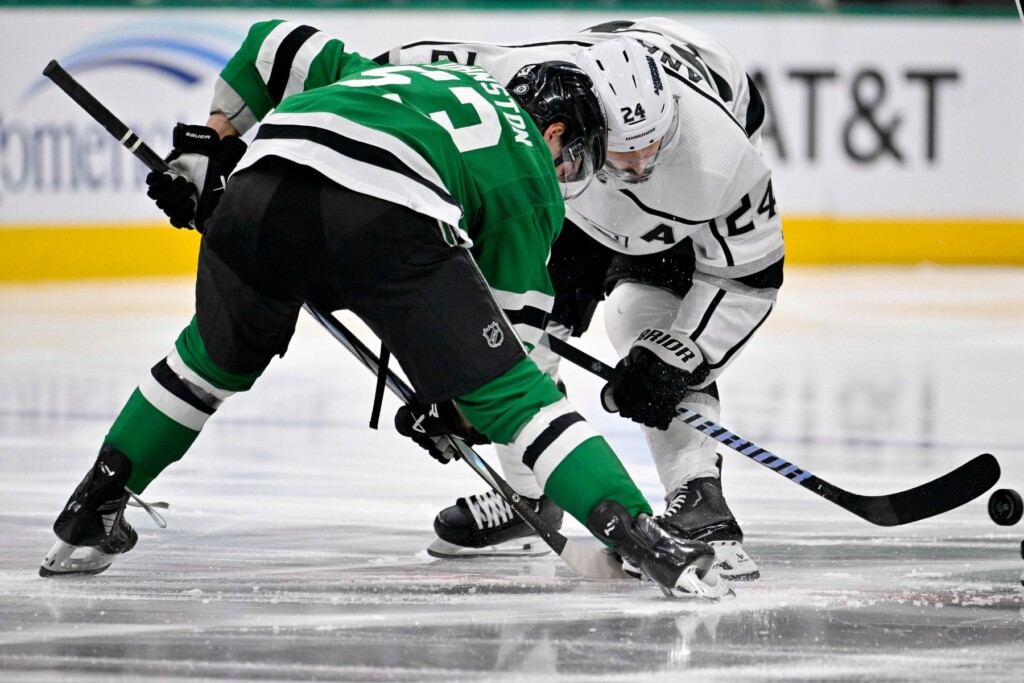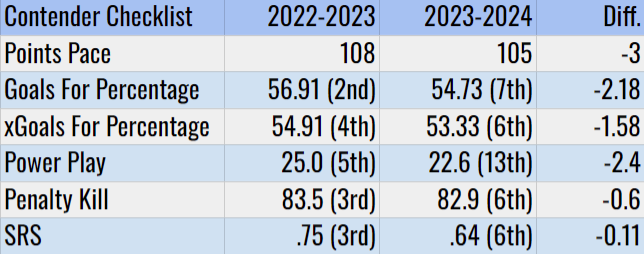The Stars stand so precariously on the Central Division ladder that they’re always a loss from falling into third place. It sounds bad until you take a step back and look at where the top three teams in the division rate compared to the rest of the NHL. Based on goal differential, Winnipeg and Colorado rank third and fourth overall, respectively. It’s not exactly reassuring, but considering that Dallas is only two points from taking the Central lead, it’s not an indictment either.
For the Stars, the challenge is less about what they can prove to themselves and more about how they ride the ebbs and flows of the remaining 33 games. With the regular season being so despicably long, patterns are susceptible to illusion. Just consider the role reversal of the L.A. Kings and the Edmonton Oilers, and how one stretch can confirm or deny that they are who we thought they were. It’s hard to imagine Dallas winning only three games over more than a month, as L.A. did. Conversely, it’s hard to imagine Dallas winning 16 straight, as Edmonton has done.
If the Stars have designs on making history, what will we need to see?
Let’s start by revisiting an exercise we did in November 2022. It is often said that as long as you make the playoffs, “anything can happen.” Except this is nonsense. Yes, anything can happen when expectations for your team are low and you achieve the unexpected, as Florida and Montreal did. But not just anyone can win a Cup. And we have a loose statistical profile for this.
Rather than recap that checklist, let’s compare these Stars to last season’s iteration using the same template.
Starting at the top, Dallas is on pace for 105 points per Micah Blake McCurdy’s model. Check. With Miro Heiskanen and Jake Oettinger back at full strength, it’s hard to imagine Dallas missing its mark on this one. The remaining schedule is a perfect blend of good, competitive teams and outright stinkers. The latter includes three games against the San Jose Sharks, and the Stars’ three-game road trip starts on Tuesday night against the Buffalo Sabres, who always look like they’re on the verge of taking that next step and then don’t. (Just don’t expect a blowout. Ukko-Pekka Luukkonen had the best save percentage of any netminder in the month of January.)
In terms of goal differential, Dallas has dropped off significantly from last season’s performance. But we know why. The most encouraging sign for the Stars will be how Oettinger handles the rest of the regular season. There’s nothing Jim Nill can do, except remain hopeful that Oettinger can find his former form. It’s a credit to the Stars that they’re still hovering just outside the top five in goal differential at plus-32. That’s a testament to their depth. If we cheat and combine the two seasons, we can give Dallas a check on this one, too.
The gap in the expected goal differential between this year’s squad and last year is a lot smaller. I’m gonna go out on a limb and say they reach top-five status, which would help fill out the profile of a true contender. I say this because for much of this season Dallas missed the usual dominance of Jason Robertson and Roope Hintz with Joe Pavelski. Then the switch to Wyatt Johnston on the top line changed everything. The new line’s expected goal differential of 84 percent is on another level—10 percentage points higher in shot quality dominance than Edmonton’s superline with Connor McDavid, Ryan Nuent-Hopkins, and Zach Hyman. The Dallas trio has outscored the opposition 9-1, with a 73-17 edge in shots. That’s just stupid.
I’d expect them to slow down, but not the way the power play has. Dallas misses the mark as a top-10 unit on this one, thanks in part to the presence of Jamie Benn. His regression is its own discussion (which was always due), as is his continued presence on the top unit (he’s good on faceoffs.) Dallas should have time to tinker with the top unit. It seems simple enough: Matt Duchene, Mason Marchment, and Tyler Seguin are all out-producing Benn when adjusting for man-advantage minutes, so why not try one of them instead? A power play doesn’t pass or fail because of one player, but it’s the simplest fix for improving a once-elite unit.
The penalty kill is solid, and it’s not something I’d expect to change. Esa Lindell and Jani Hakanpaa are first and third, respectively, in shorthanded time on the ice per game (well over three minutes). Thinking out loud: their performance on the penalty kill might be the single biggest clue that Nill might not add a defender at the March 8 deadline. If the penalty kill is good and both defenders are a big part of that, Nill probably won’t want to disrupt the chemistry. In that scenario, who’s the odd man out? Nobody, in my view. Ryan Suter is the most expendable blueliner, but he’s also the least moveable with his no-move clause.
This is where Nill’s job at the deadline becomes a philosophical dilemma more than a mandate. The conventional wisdom is that Dallas needs an upper-echelon blueliner in order to push all of its chips in. Let me push back on that for a second. For one, the prices being paid of late for marginal upgrades are ludicrous. Sean Monahan, not even worth an extra two points in the standings per Evolving-Hockey, was not worth a first-round pick. Elias Lindholm, who would be eighth in scoring in Dallas, definitely wasn’t worth a first-round pick and certainly wasn’t worth a first-round pick and an elite prospect. Dallas has holes on the blueline, but the time to fix them was in the summer, not now.
There’s a scenario where he does nothing at the deadline, and Dallas is rewarded for it. Logan Stankoven and Mavrik Bourque are, quite frankly, too good for the AHL. Lian Bichsel, before he went to Sweden, was too good for the AHL. All of these players will be available by the time Dallas is playoff-bound. Thomas Harley’s ability to jump into the frying pan at the age of 22 might as well be the stuff of legend. In some ways, his ascension serves as a blueprint. Harley may be an exception instead of the rule, but Dallas’ three top prospects are exceptional in their own right. Instead of mocking the possibility with cliches, Nill might be better served by embracing the depth he has beyond his NHL roster.
The flip side is that there’s a scenario where Nill not doing anything to improve punishes his team. We can mock the silly prices Winnipeg and Vancouver paid for their upgrades, or we can view them as just that: as upgrades. Having Monahan, who has broken the 60- and 80-point barrier, centering Cole Perfetti and Nikolaj Ehlers instead of Vladislav Namestnikov, who has exceeded 40 points only once, is an upgrade. Having Lindholm add defense to the Canucks’ already-formidable forward unit is an upgrade.
It’s tempting to get sucked into the psychology of mutually assured destruction and to get a head start on the arms race. Nill has never been that type. Will he have to change his mindset, given the absurd quality of opposition in the Central, not to mention the Pacific? Or will he lean on the strength of what he’s deliberately built going back to the 2017 draft class?
The second half will either be a validation of his patience, or a rejoinder.
Author








